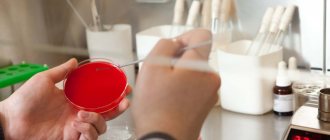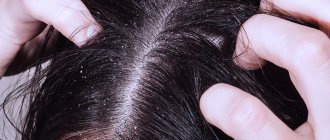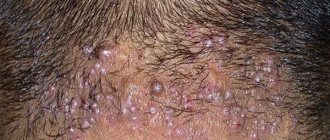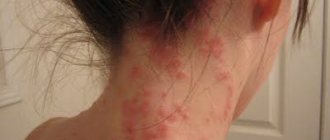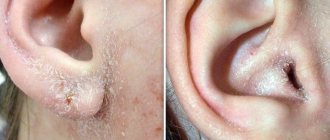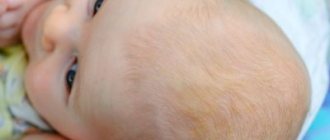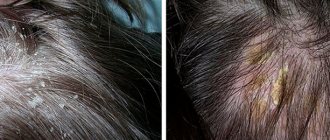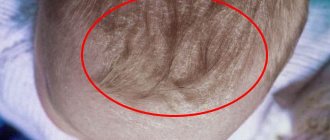Women carefully monitor their appearance. But often the following problem arises: the forehead peels off. There are many reasons why this happens. This problem needs to be dealt with somehow. This article will talk about the reasons why peeling occurs. An explanation will also be given of what to do with flaky skin.
Signs
There are several signs that you can tell if you have dry skin:
- Peeling.
- Itching.
- Tightness.
The most delicate and sensitive area on our face is the forehead. It takes the brunt of the blow, so the first place you can see these signs is on the forehead, since this area is susceptible to drying out. In order to prevent peeling of the skin in this area, it is worth using special skin care products. It is necessary to purchase moisturizing cosmetics to prevent these three unpleasant signs of dry skin in the near future.
Immunodeficiency state
The concentration of fungal flora remains within normal limits when the immune system is functioning normally. When it decreases, pathogenic organisms begin to behave aggressively. This may explain the fact that in patients with AIDS, seborrhea occurs in 80% of cases, and in patients with HIV infection - in 40%. There are primary and secondary conditions of immunodeficiency.
In the first case, it is AIDS and HIV infection. The latter are the result of some disease. Examples include diabetes mellitus and helminthic infestation. Dermatitis in such people is often protracted, sometimes becoming chronic. It becomes difficult to cure it.
Causes
But in order to completely remove this problem from life, it is still worth understanding the problem. Why does the skin on my forehead peel? The reasons are as follows:
- The first and most important point is that soap dries out the skin. You should wash your face only with warm or cool water, as very hot water will harm your facial skin.
- If you like to use a heater in the cold season, then you should remember one important thing: it also leads to oxygen starvation of your body, or rather the skin of your face.
- Sudden climate changes are especially dangerous for the skin. In cold weather, try to use special cosmetics for the care and resuscitation of the skin, as the skin also tends to dry out and crack. At this time of year, use less decorative cosmetics, and it is better to completely remove them from your winter cosmetics bag.
Even if you do a full range of facial skin care and take into account every little detail, you must not forget about the problems of the body itself. Diseases of internal organs can affect a person’s appearance. There are a number of reasons why dry skin may occur in women and men at different ages.
Hormonal disorder of the body
It leads to a number of health problems in women. In addition to cycle disruptions, depression, nervous breakdowns, today’s topic (dry skin) also joins this list of troubles. Due to a lack of hormones in the body, the skin becomes less elastic, loses its tone and flakes. But this problem can also arise with age during menopause. Estrogen in our body decreases critically, as a result of which the body suffers greatly and endures great stress. At such moments, wrinkles and age spots begin to appear on the skin, and it loses its elasticity.
Malassezia furfur
It is a yeast-like fungus. It belongs to the category of lipophilic organisms, that is, it prefers a fatty environment. For the same reason, microorganisms use the secretion of the sebaceous glands to maintain their vital functions. Its main shapes are round and oval. The latter is usually found on the scalp.
When examining patients with seborrhea, the concentration of the oval-shaped fungus in them is up to 95%. The following factors activate the growth of pathogenic flora:
- failure of the hormonal system;
- pathologies of the central nervous system, as well as the autonomic system;
- state of immunodeficiency;
- gastrointestinal diseases;
- taking medications;
- stress.
Skin diseases
There are various diseases that will help you understand why dry forehead appears. These are pathologies such as allergic reactions, fungus, psoriasis, seborrhea, dermatitis. In these cases, the skin not only peels off, it turns red, itches, and rashes may also appear, which may have a different etiology. If you are concerned about these symptoms, do not delay visiting a dermatologist. At the initial stage, it will be easier for him to understand what happened and what is the reason. If you consult a specialist in a timely manner, there is a chance for a quick recovery.
Therapeutic measures
As soon as any lesions form on the surface of the skin, you should make an appointment with a dermatologist. First, he conducts a survey, after which he examines the patient and evaluates his skin symptoms. An obligatory step is writing out directions for laboratory tests.
During the examination, the dermatologist analyzes the form of manifestation of the external symptoms of the disease and the areas to which they have spread. At the same time, he asks the patient how quickly his symptoms began and with what frequency they bothered him. The tests require laboratory assessment of the levels of hormones and glucose, and a referral is also issued to test stool for dysbacteriosis. People with diabetes are at risk because their immune system is quite suppressed.
What skin changes occur in adulthood?
Peeling skin on the forehead is more often a problem for women than men. One of the reasons for peeling skin lies in the fact that the structure of a woman’s internal body changes, and, as mentioned above, changes occur. There is only one conclusion: you need to take care of your skin from adolescence. Perhaps this way you can avoid a number of reasons why problems with the skin on the forehead arise, and not only.
If you use cosmetics correctly, you can avoid a lot of discomfort on your face. This means that you first need to learn how to use scrubs and lotions. If you do everything at random and do not follow the rules, this can lead to the following problems:
- Peeling of forehead skin.
- Hyperemic areas of skin appear on the face. This indicates that some cosmetic product was carefully rubbed into the face.
- Peeling may go away, but for a short period, after a while it appears again.
One of the factors may be that you use low-quality cosmetics. In this case, try replacing it. If this does not help, then it is best to contact a dermatologist so that he can help identify the cause of the problem in the early stages.
The mechanism of seborrheic dermatitis
Human skin is not only a protective covering of the body. It is an organ that performs many functions. Every day it secretes up to 50 g of sebum and one liter of water, saturated with salts and waste products of the body. There are many skin diseases, including seborrheic dermatitis.
Seborrheic dermatitis is a common skin disease. From its name you can understand what it is connected with. “Sebum” – sebum, “rhea” – modification, change of role. With seborrhea, there is excessive production of sebum, the secretion of the sebaceous glands.
Two interdependent processes arise simultaneously:
- conditions on the surface of the skin change due to dysfunction of the glands;
- changed conditions provoke further progression of the dysfunction of the sebaceous glands.
Normally, yeast-like fungi, which are part of the microflora, live on the surface of the skin. As conditions change, they begin to actively reproduce. For this reason, inflammatory processes occur, peeling of the stratum corneum, itching, and the formation of plaques from dead cells.
These processes preferentially develop in places of greatest concentration of sebaceous glands. But they can also cover other areas of the face.
Seborrheic dermatitis most often affects the following areas:
- nasolabial cavities;
- cheeks;
- brow ridges and eyebrows;
- areas of the wings of the nose;
- bridge of the nose;
- scalp;
- areas of facial hair growth in men;
- eyelids;
- ears and behind-the-ear hollows.
Causes of dysfunction of the sebaceous glands
- Diseases of the thyroid gland and pelvic organs (in women).
- Changes in hormonal balance in men and women.
- Gastrointestinal diseases.
- Stressful and depressive conditions.
- Decreased immunity.
- Age characteristics (periods of puberty and decline of sexual function).
- Consumption of foods containing allergens.
Features of seborrheic dermatitis on the face
The face is an open part of the body that is constantly in contact with the environment.
The skin covering the face contains a large number of sweat and sebaceous glands. This provides the ability to quickly respond to external influences.
A thin film of sweat and sebum (water-fat mantle) is a barrier that prevents the penetration of germs and bacteria into the cells of the dermis. This purpose is also served by the acidic environment on the surface of the facial skin, which kills pathogenic microorganisms.
With a decrease in immunity and for other reasons listed above, the function of the sebaceous glands is disrupted with all the ensuing consequences: the proliferation of yeast-like fungi, inflammatory processes, dandruff. Seborrhea develops.
This disease comes in three types:
- fat;
- dry;
- mixed.
Dermatology regards seborrhea as a recurrent disease, which, once formed, can accompany a person throughout his life. To minor changes in conditions inside the body or on the surface of the skin, the body will react with corresponding symptoms: the appearance of dandruff, itching, redness.
Not only a dermatologist, but also doctors of other specialties: endocrinologists, gynecologists, andrologists, oncologists, neurologists can take part in the treatment of seborrhea.
Proper skin care
In most cases, people's skin has its own individual structure, and can react differently to each drug. If your forehead is red and flaky, you should consult a dermatologist about the best drug to take. It could also be some kind of additives. But if visiting a dermatologist is a last resort for you, try using regular folk remedies for facial skin care.
- To prevent dry skin from disturbing your peace, you should drink at least two liters of clean water a day.
- Before washing your face, fill a mug with water and let it sit for a while, as tap water is chlorinated and also dries out your skin.
- Water should definitely be at room temperature, since too hot or too cold irritates the epidermis, which affects the result of washing.
- Choose cosmetics for yourself that do not contain alcohol.
- The face towel should be soft and should not rub your face like sandpaper. This causes harm to your skin.
- Buy yourself a moisturizing toner and use it every time after washing your face.
- It also doesn’t hurt to use creams or oils to moisturize the skin.
- Make face masks only from natural products and only on your own.
- You can buy vitamins A and E separately at the pharmacy; they will help you keep your skin in good condition. These vitamins can be added to the cream.
- Exfoliate your face periodically. This is a very effective procedure, many women use it.
List of drugs
There is no universal remedy for seborrheic dermatitis on the head. This requires an integrated approach. The main groups of drugs are:
- antifungal;
- antihistamines;
- glucocorticoids;
- antibiotics;
- keratolytics, which include salicylic acid and zinc preparations.
A group of antihistamines reduces the severity of redness, itching, and swelling. They are prescribed in tablet form for 10 days. Among antihistamines, Loratadine and Clemastine are recommended. They manage to fight inflammation and itching. So-called hyposensitizing agents are also necessary: sodium thiosulfate and calcium gluconate. They are administered as intravenous or intramuscular injections.
Antifungal agents are a kind of basis for the treatment of dermatitis. They stop the spread of the infectious agent. The drugs come to the market in the form of tablets, ointments and shampoos. If the form of the disease is mild or moderate, you can get by with local treatment of seborrheic dermatitis of the scalp. When the disease affects large areas, a systematic approach is required. Antifungal medications are Fluconazole and Clotrimazole. Ketoconazole is also widely used. To reduce the severity of irritating manifestations of the disease, they are sometimes used together with glucocorticoids.
Keratolytics soften plaques and scales and promote their rejection. Antibiotics are required if a microbial infection occurs. These may be tetracycline antibacterial agents and Metronidazole. Usually they are used in a loading dose, after which they switch to a smaller amount. Ointments are often used:
- Hydrocortisone. It fights swelling and redness, eliminates inflammation. The course of treatment with this remedy is no more than 14 days. Apply it 2 times a day in a thin layer.
- Dexamethasone. It has proven itself well in the fight against key manifestations of the disease. Apply it to the affected areas twice a day for 1 week. Sometimes the course can be extended to two weeks.
- Triderm. It is considered a combination drug containing Gentamicin, Clotrimazole and Betamethasone. It is able to destroy microbes and fungus, as well as eliminate inflammation. Treatment with this remedy lasts from 3 to 4 weeks. The composition is applied not only to areas with defects, but also to adjacent healthy tissue.
Treatment for seborrheic dermatitis of the scalp may not be so simple, but if you seek help in a timely manner, you can count on a quick transition to remission. Of great importance is the extent to which a person is willing to follow the doctor’s instructions and not deviate from these recommendations. The occurrence of dermatitis seborrhea should not be a cause for panic. When improvement occurs, you should not stop taking the prescribed medications.
Jojoba and other remedies
What to do if your forehead is flaky and itchy? You should use jojoba oil; it can be used most often, as it contains a large number of beneficial microelements, and you don’t have to worry about oily facial skin and clogged pores. These problems will be avoided. You can also use flaxseed oil, olive oil and argan oil, but in small quantities.
There is a list of solid oils that are used in cosmetology, but they must be used very carefully, as they can contaminate the pores and make your already unhealthy skin even worse. These are coconut, mango, shea and cocoa butters. They should be applied only to those parts that need to be moisturized, but under no circumstances to the entire face.
Folk remedies for the treatment of seborrheic dermatitis on the face
Traditional medicine offers a wide range of remedies for the treatment of seborrheic dermatitis on the face. First of all, these are herbal decoctions and tinctures. It is recommended to regularly wipe the face with decoctions that have an anti-inflammatory and cleansing effect.
Preparations based on the following herbs are effective:
- series;
- tricolor violet;
- pharmaceutical camomile;
- viburnum bark;
- liquorice root.
You can prepare your own medicinal ointment by mixing equal parts sea buckthorn oil and goose fat. Instead of goose, you can use pork. Compresses made from a decoction of oak bark, calendula, and lemon balm are effective.
Treatment with birch tar
A universal and inexpensive treatment for seborrheic dermatitis is birch tar. This substance has a complex effect.
It relieves inflammation, itching, and neutralizes pathogenic microflora. The antifungal and antimicrobial effects of birch tar have been proven.
This drug has a specific odor and leaves traces after application. Therefore, treatment procedures are carried out at a time when it is possible not to leave the house for 2-3 hours. Tar is applied pointwise to the affected areas. Use a cotton swab or cotton pad. Before use, prepare tar water: 1 tsp of tar per 8 tbsp of water. This solution is applied to the face.
Peeling of the forehead in a child
Do babies' foreheads get very flaky? This happens quite often, but to eliminate the problem, a different approach is needed, since the child does not require cosmetic facial care products (masks, scrubs, lotions, creams). Parents most often perceive this behavior of the child’s body as normal. The main role is played by environmental factors:
- You should not expose your child to ultraviolet radiation frequently.
- Go for a walk, but do not forget about the effect of the wind on your baby's skin. In winter, a baby can get frostbite very quickly, so avoid long walks.
- Diseases, such as seborrheic dermatitis, fungus, chickenpox, and scarlet fever, can also affect a child’s skin. Be vigilant about your baby's health.
- Peeling of the skin also depends on the condition of the liver and intestines.
- At a very young age, a baby is susceptible to allergic reactions, which also affect his skin. The forehead peels off especially often in such cases. Consult your pediatrician to see if you should eliminate something from your diet.
Do not relieve yourself of responsibility, since child care is very important, and hygiene procedures should be carried out with him as intended. If you do not maintain your baby’s hygiene, then perhaps you will soon see detached particles on the skin.
Preparations for the treatment of peeling skin
What to do if the skin on your forehead is peeling? This question often arises among women. In addition to oils, you can turn to medications.
"Geoxyzon" is a broad-spectrum ointment. Its properties are applied to problems such as peeling of the skin, purulent boils, dermatitis, sunburn, and insect bites. Apply to problem areas of the skin at least three times a day. This ointment also has contraindications: it is contraindicated for pregnant women, breastfeeding women and people with skin cancer.
“Mikozoral” is an ointment for peeling the skin. Apply at least twice a day. The effectiveness of the drug is visible from the first dose. After a course of taking this ointment, the skin becomes smooth and elastic. Contraindicated for people with allergic reactions to any component of the composition.
Malfunction of the central nervous system
The activity of the autonomic system is controlled by the central nervous system.
This may explain the impressive prevalence of seborrhea-type dermatitis among people with diseases of the nervous system and mental problems.
At risk are people with:
- encephalitis;
- psychoses;
- schizophrenia;
- Parkinson's disease.

